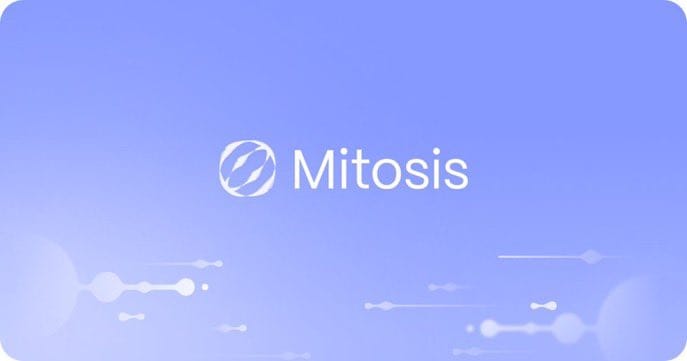Mitosis: A New Blueprint for Liquidity in DeFi

In the constantly evolving landscape of decentralized finance (DeFi), few projects manage to shift paradigms rather than just iterate. Mitosis isn’t just another DeFi protocol, it’s a modular programmable liquidity layer being purpose-built for the multi-chain future. Mitosis is creating a new foundation where yield becomes programmable infrastructure, not just passive income.
This article offers a comprehensive dive into what Mitosis is, how it works, and why it’s uniquely positioned to redefine cross-chain DeFi through innovation, composability, and builder-centric design.
Introduction: The Problem Mitosis is Solving
DeFi was supposed to be borderless. But in reality, chains have become silos, fragmented ecosystems with friction-heavy bridges and yield strategies locked within single ecosystems. Capital mobility across chains is clunky, expensive, and often dangerous.
Mitosis steps in to address a foundational issue: how do we make liquidity composable and programmable across all chains, without giving up security, sovereignty, or user control?
By reimagining yield not as an endpoint, but as an asset layer, Mitosis opens up powerful new primitives for developers, users, and protocols alike.
What Is Mitosis?
At its core, Mitosis is a modular, cross-chain liquidity and yield layer. It enables users to deposit assets and receive programmable token representations called miAssets that can move, earn, and build across chains.
Mitosis isn’t just a vault. It’s an ecosystem with two main components:
- Matrix – The user layer that hosts vaults, interfaces, and intuitive strategies for earning and managing yield.
- EOL (Ecosystem-Owned Liquidity) – A permissionless backend layer for protocols to bootstrap and coordinate liquidity collaboratively.
Together, these two systems form a scalable infrastructure where liquidity is no longer a limitation, but a canvas.
The Building Blocks of Mitosis
miAssets: Liquidity Reimagined
When a user deposits into Mitosis, they receive miAssets cross-chain tokens that retain a 1:1 relationship with the underlying asset. But here’s the kicker: these aren’t just static receipts. miAssets are:
- Composable: Usable across DeFi protocols
- Portable: Bridged across supported chains
- Productive: Continuously earning yield from underlying strategies
In other words, they are yield-bearing tokens by default, not by integration.
Spindle: Yield Separation Engine
SpindleAG, a key module in the Mitosis stack, splits yield into two distinct parts:
- Principal Token (PT) – Your original deposit.
- Yield Token (YT) – The future yield from that deposit.
This separation unlocks trading, hedging, and leveraging yield itself, making yield a liquid market rather than a passive return.
Cross-Chain Infrastructure
Mitosis is chain-agnostic and interoperable. Whether you're on Ethereum, Arbitrum, ZK chains, or L2s like Base or Blast, Mitosis enables assets to:
- Move between ecosystems without fragmentation
- Earn across chain boundaries
- Maintain composability across DeFi protocols
Using fast-finality bridges, light client verification, and native minting models, Mitosis builds liquidity highways, not toll booths.
The Two-Layer Design: Matrix vs. EOL
Matrix – The User Interface Layer
The Matrix is Mitosis' friendly frontend. This is where users:
- Deposit into vaults like LRTs (Liquid Restaking Tokens)
- Earn optimized and auto-compounded yields
- Get composable assets to use elsewhere
Key features of Matrix:
- Liquidity remains user-owned
- Capital remains flexible
- Designed for individuals, DAOs, and aggregators
Matrix is where yield meets usability.
EOL: Ecosystem-Owned Liquidity Layer
While Matrix is user-focused, EOL is protocol-focused. It allows other projects to:
- Create vaults without permission
- Bootstrap and share liquidity
- Co-own strategies with aligned incentives
EOL is designed for protocols, service providers, and ecosystems that want to build shared infrastructure, not rent liquidity.
The uniqueness lies in this separation: Mitosis respects the needs of both users and builders, giving them distinct, tailored layers.
Why Mitosis Stands Out
Programmable Yield
Most yield protocols treat APY as the end product. Mitosis treats it as the beginning. By making yield programmable via PTs and YTs, Mitosis unlocks:
- Yield trading (long/short)
- Fixed yield markets
- Structured products and vaults
- Custom risk exposures
Developers can build with yield as a primitive, not just an output.
Native Cross-Chain Composability
Where most bridging solutions break composability, Mitosis preserves it. miAssets remain usable on every supported chain with minimal delay and slippage, creating a unified liquidity experience.
Ecosystem-Native Liquidity
Rather than compete for liquidity, Mitosis enables ecosystems to own and manage their own. EOL empowers protocols to collaborate on liquidity provisioning and share incentives in a trust-minimized way.
This reduces mercenary farming, aligns incentives, and lowers bootstrapping costs.
Builder-First Culture
Mitosis is deeply integrated with tooling and research hubs like MikadoHubLabs a launchpad for new builders, researchers, and DeFi primitives. By offering modular SDKs, battle-tested strategies, and mentorship, it lowers the barrier to entry for builders.
Real-World Use Cases
For Users
- Deposit ETH into a restaking vault on Mitosis Matrix
- Receive miETH that earns restaking yield passively
- Use miETH across chains to farm or LP
- Later, split miETH into PT + YT and sell YT for immediate profit or hedge
For Protocols
- Launch a custom vault on EOL for your native token
- Incentivize shared liquidity with yield-sharing mechanics
- Use Spindle to generate yield strategies that match your risk appetite
For DAOs
- Park idle treasury in PT-only strategies
- Hedge volatility by converting yield into stables
- Offer community yield exposure with composable risk profiles
Governance and Decentralization Roadmap
Mitosis is progressively decentralizing. Governance will be rolled out through a phased approach involving:
- Multi-sig guarded launches
- DAO participation in vault design
- Community-owned incentive allocation
- Open strategy submission and curation
As liquidity grows, governance will transition toward full protocol control by token holders and ecosystem stakeholders.
The Road Ahead
Mitosis isn’t just planning features—it’s architecting a movement:
- Expanded chain support: Seamless integration with emerging L2s and ZK rollups
- Programmable vault SDKs: No-code vault builders for protocols
- Yield-Fi infrastructure: Building fixed-income and derivative products natively on-chain
- EOL DAO tooling: For aligned liquidity coalitions across ecosystems
Why This Matters Now
DeFi is shifting. The multi-chain future is already here, and liquidity is the limiting reagent. Protocols that solve the liquidity problem without fragmenting users will be the backbone of Web3’s financial system.
Mitosis doesn’t just patch the problems, it offers a new base layer. A modular foundation where capital moves freely, yield becomes a programmable resource, and builders gain new creative freedom.
In the same way Ethereum abstracted away infrastructure for developers, Mitosis abstracts liquidity itself—turning it from a bottleneck into a canvas.
Conclusion:
The brilliance of Mitosis lies not in what it replaces, but in what it enables.
By building programmable, composable, cross-chain liquidity primitives from the ground up, it sets a new standard for how DeFi operates across ecosystems. Whether you're a user looking for simple, productive assets or a protocol ready to collaborate on shared liquidity, Mitosis offers the tools and the vision to make it possible.
If DeFi is the operating system of the new financial world, Mitosis is building its liquidity kernel.
You can read Mitosis Litepaper for a deeper insights, read about SpindleAG (https://spindle.ag/) and join Mitosis Discord or X communities to connect with us, share ideas, and stay updated.


Comments ()